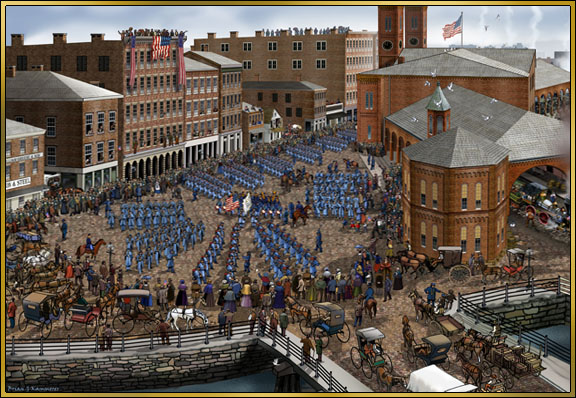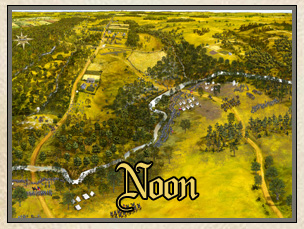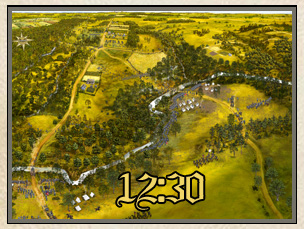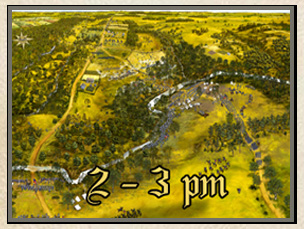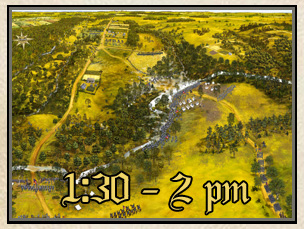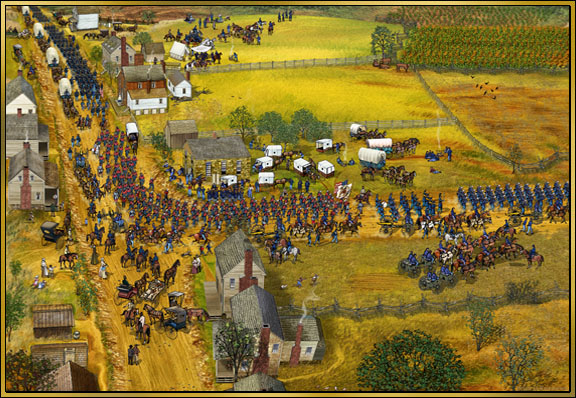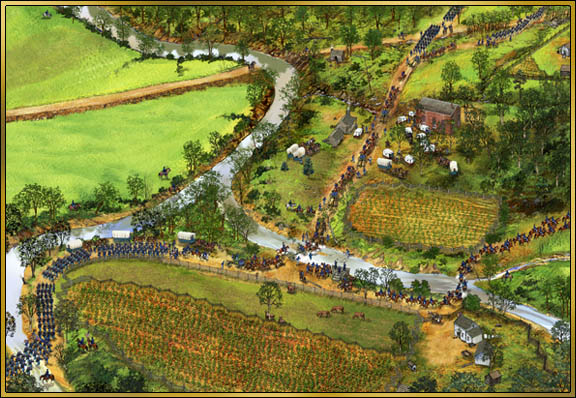
 |


Departure of SouthernTroops for Manassas
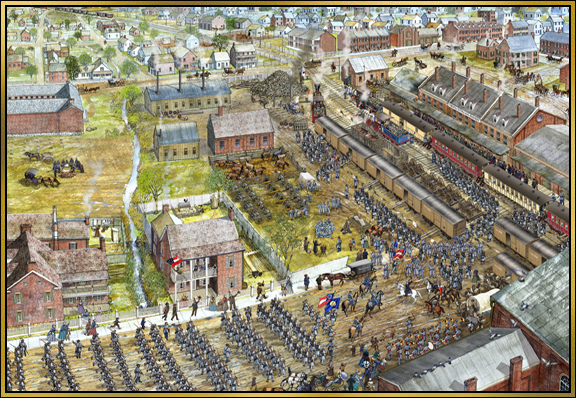
Click here to view close up cropped images of this print
The time now came for the troops to depart from the camps in and about Richmond. A spring shower has puddled the rutted tracks of Broad Street. The 1st Va have doned their Militia overcoats to keep the chill off and to be comfortable for the ride North. The destination was the rail Junction at Manassas in Northern Virginia. This was the new assembly point just 20 miles from Washington. Federal Militia troops responding to the call from Lincoln were arriving daily to defend the Capital from possible Confederate attack and a possible thrust into Virginia to capture this important rail junction at Manassas. The Virginia Central RR was the most direct route there with a change of trains at the connection with the Orange and Alexandria rail road. The troops have marched from Camp Lee at the other end of Broad Street to board the awaiting consists of boxcars and passenger cars .President of the Confederacy, Jefferson Davis and General R E Lee are there to see the troops off. There is a festive and hopeful air about the departure as the band plays a melody of tunes including Dixie and the Bonnie Blue Flag. Civilians gather along the platform in hopes of spotting a departing son or husband. Artillery carriages have been lashed down and chests and gun barrels secured and placed beneath for the long ride. Some troops are getting the privilege of riding in passenger cars. Either way it will be a long and uncomfortable journey.
*Artist note-.Since the original area is radically changed and nothing exists of the original Virginai Central RR Depot I have taken liberties with its style and design.I have kept the buildings style close to those that existed as Central depot of that era and of similar design to the architectural norm of Richmond. While researching information to composite this illustration, a Google Real Estate map crop alerted me to the fact that the area below where the Richmond City Jail originally stood was believed to be an Old Slave Burial Ground. The concurrent burial of this slave and the departure of the troops to fight in a Civil War to preserve the states right to keep this institution alive was just too allegorical not to include.

Departure of Burnsides 1st Rhode Island from Providence
Click here to view close up cropped images of this print
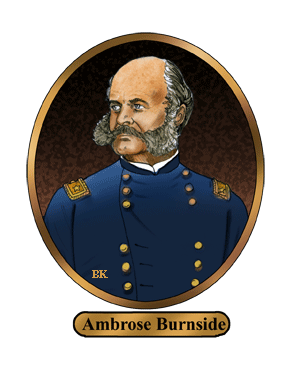 The State militias had responded willingly to the call to take up arms in defense of the nation. These men would serve 90 days. The Seventh New York Regiment, a crack parade unit, dressed in white cross belted gray tunics, left on the 19th of April to defend the Nation's Capital. They were cheered on by enthusiastic crowds that lined the streets of Broadway to see them off. Farther north, one thousand troops of the 1 st Rhode Island Infantry marched past cheering, handkerchief flagwaving crowds to the Providence railroad station en route to Washington D.C.They would not depart by train though. There was no direct line between RI and the capitol. They would board one of the large seagoing Steamboats at the nearby wharf and sail down the coast to the Chesapeake River and then up the Potomac to Washington.Some of the women were weeping or wringing their hands at the departure of a loved one. The boys were off to be soldiers in a great cause to defend the Capital. The shriek of the locomotive whistle announced that they were about to depart, perhaps forever. The train moved out of the depot, amid the wild cheers of the men and the crying of the women and children. It was a sight never to be forgotten. Upon their arrival in Washington after a long arduous trip of stops and transfers, their commanding officer, Colonel Ambrose Burnside, was told to requisition supplies for his men. Aware how little the quartermaster had on hand, Burnsidereplied, “Rhode Island and her governor will attend to their wants.”
The State militias had responded willingly to the call to take up arms in defense of the nation. These men would serve 90 days. The Seventh New York Regiment, a crack parade unit, dressed in white cross belted gray tunics, left on the 19th of April to defend the Nation's Capital. They were cheered on by enthusiastic crowds that lined the streets of Broadway to see them off. Farther north, one thousand troops of the 1 st Rhode Island Infantry marched past cheering, handkerchief flagwaving crowds to the Providence railroad station en route to Washington D.C.They would not depart by train though. There was no direct line between RI and the capitol. They would board one of the large seagoing Steamboats at the nearby wharf and sail down the coast to the Chesapeake River and then up the Potomac to Washington.Some of the women were weeping or wringing their hands at the departure of a loved one. The boys were off to be soldiers in a great cause to defend the Capital. The shriek of the locomotive whistle announced that they were about to depart, perhaps forever. The train moved out of the depot, amid the wild cheers of the men and the crying of the women and children. It was a sight never to be forgotten. Upon their arrival in Washington after a long arduous trip of stops and transfers, their commanding officer, Colonel Ambrose Burnside, was told to requisition supplies for his men. Aware how little the quartermaster had on hand, Burnsidereplied, “Rhode Island and her governor will attend to their wants.”
*I have dressed the 1st RI in greatcoats for artistic reasons than just their smock shirts.

Marshall House, Alexandria Va. May 24th 1861
Click here to view close up cropped images of this print
The day after Virginia seceded from the Union, Federal forces were ordered to cross the Potomac River
and seize critical points on the Virginia side. Colonel Ellsworth and his regiment of Fire Zouaves,
the 11th NY Regiment, were given the honor of this choice mission. Their goal was to capture the
railroad station and telegraph office. As they departed from the wharf and headed up King Street,
a large Confederate flag was flying atop the Marshall House at the intersection with Pitt Street.
 Ellsworth wanted that flag taken down immediately.
Ellsworth wanted that flag taken down immediately.
Stationing guards inside the inn, Ellsworth dashed upstairs with four comrades. Reaching the roof he cut down the flag and headed back down the stairs to the street. Proceeded by
Corporal Francis E Brownell and followed by Edward H. House, a reporter with the New York Tribune, they were met on the third-floor landing by the innkeeper James W. Jackson brandishing
a double barreled shotgun. As Brownell tried to parry the shotgun aside with his musket, Jackson
pulled the trigger. Ellsworth was hit full in the left breast by the blast and fell dead atop the now bloodied Confederate flag.
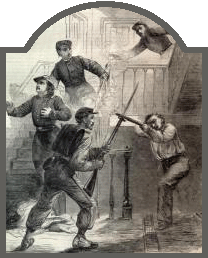
Jackson fired again this time at Brownell but missed. The Corporal fired simultaneously and hit the innkeeper full in the face. As Jackson fell dead he was bayoneted by Brownell and sent crashing 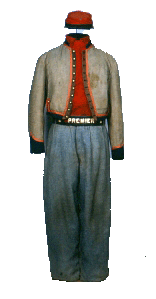 down the stairs. Ellsworth’s death plunged the North into mourning. Bells tolled and flags flew at half mast to honor
down the stairs. Ellsworth’s death plunged the North into mourning. Bells tolled and flags flew at half mast to honor
the fallen hero and friend of President Lincoln. At the sight of his young friend’s body, he sobbed,
“My boy! My boy! Was it necessary that this sacrifice should be made?”

Map of Manassas Jnct. & the Rail lines of Northern Va.


Manassas Junction 1861
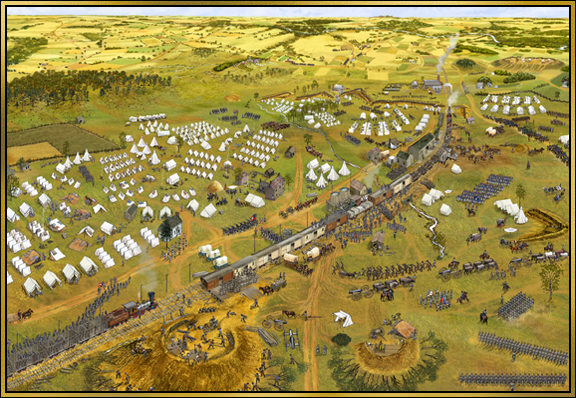
Click here to view close up cropped images of this print
Following Virginia’s decision to secede from the Union in April 1861, Southern troops began arriving here at the small village of Tudor Hall, which soon came to be known as Manassas Junction. This place, where the Orange & Alexandria and Manassas Gap railroads intersected, was quickly transformed from a quite farming community into a military stronghold. Some 20,000 new recruits poured in from across Virginia and other Southern states. Confederate leaders recognized the importance of holding Manassas Junction against an assault by Union forces. Possession of the junction meant control of the only continuous rail link between Washington, D.C. and the Confederate capital, Richmond, as well as the connection to the agricultural bountyof the Shenandoah Valley.In June 1861, Confederate Gen. P.G.T. Beauregard took command of the troops defending 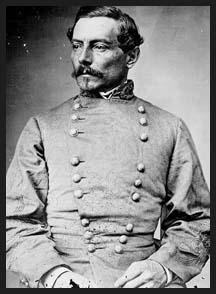 Manassas Junction.PT Beauregard, Beauregard was trained as a civil engineer at the United States Military Academy and served with distinction as an engineer in the Mexican-American War. Following a brief appointment at West Point in 1861, with the South's secession, he became the first Confederate brigadier general. He commanded the defenses of Charleston, South Carolina, at the start of the Civil War at Fort Sumter on April 12, 1861. Seeking to utilize all available resources, he issued a proclamation to the people of Loudoun, Fairfax, and Prince William counties calling on them to contribute to the military preparations. Some of the resources were human. Slaves from area farmers were sent to work alongside Confederate soldiers to construct a ring of breast- works around the Junction .
Manassas Junction.PT Beauregard, Beauregard was trained as a civil engineer at the United States Military Academy and served with distinction as an engineer in the Mexican-American War. Following a brief appointment at West Point in 1861, with the South's secession, he became the first Confederate brigadier general. He commanded the defenses of Charleston, South Carolina, at the start of the Civil War at Fort Sumter on April 12, 1861. Seeking to utilize all available resources, he issued a proclamation to the people of Loudoun, Fairfax, and Prince William counties calling on them to contribute to the military preparations. Some of the resources were human. Slaves from area farmers were sent to work alongside Confederate soldiers to construct a ring of breast- works around the Junction .
“We are expecting an attack every day on the Junction; ordered hands out to assist in throwing up a breast-work. Jack and our hands with others from the neighborhood start in the morning bright and early.”
Diary entry of Amanda Virginia Edmonds of Fauquier County, Va., June 6, 1861
The Mayfield earthwork, known in military engineering terms as a redoubt, was a circle of raised earth some 200 feet in diameter. It may have included a retaining wall of timbers and brush, and planks to support artillery. While capable of self-defense, a redoubt was designed to provide overlapping fields of fire with other earthworks.

Fort Corcoran and the Assembling of the Army around Washington
How many men were heading to Washington? A Massachusetts volunteer answered for his state, “We're all a-comin'!” In the early morning hours of May 24 th Union columns crossed the Potomac. One proceeded south via the Long Bridge and the other east by way of the roadway atop Potomac aqueduct at Georgetown. These units advanced two miles into Virginia forcing the thin line of Confederate pickets on the Virginia side of the river to retreat. Arlington heights were now secured as was the mansion of Robert E. Lee. Alexandria was occupied but not without loss: Colonel Ellsworth the commander of the New York Fire Zouaves was killed. The operation was a success. New camps were established and forts laid out for construction by engineers. Washington would be defended. The Irish 69th New York Militia can be seen here with pick and shovel working on the fort named after their commander, Colonel Michael Corcoran. The mighty turnout of militia units and volunteers created logistical problems that would take time to solve. The discomfort and confusion dampened the ardor of some recruits. The greater majority of volunteers remained in fine spirits despite the hardships. Gen Winfield Scott and President Lincoln can be seen in the carriage observing the progress of the defenses. The red legged 14 th Brooklyn are assembled on their parade ground to welcome the President. Across the Potomac is the unfinished dome of the Capital building and the Washington monument also under construction.

McDowell's Army Advances to Bull Run
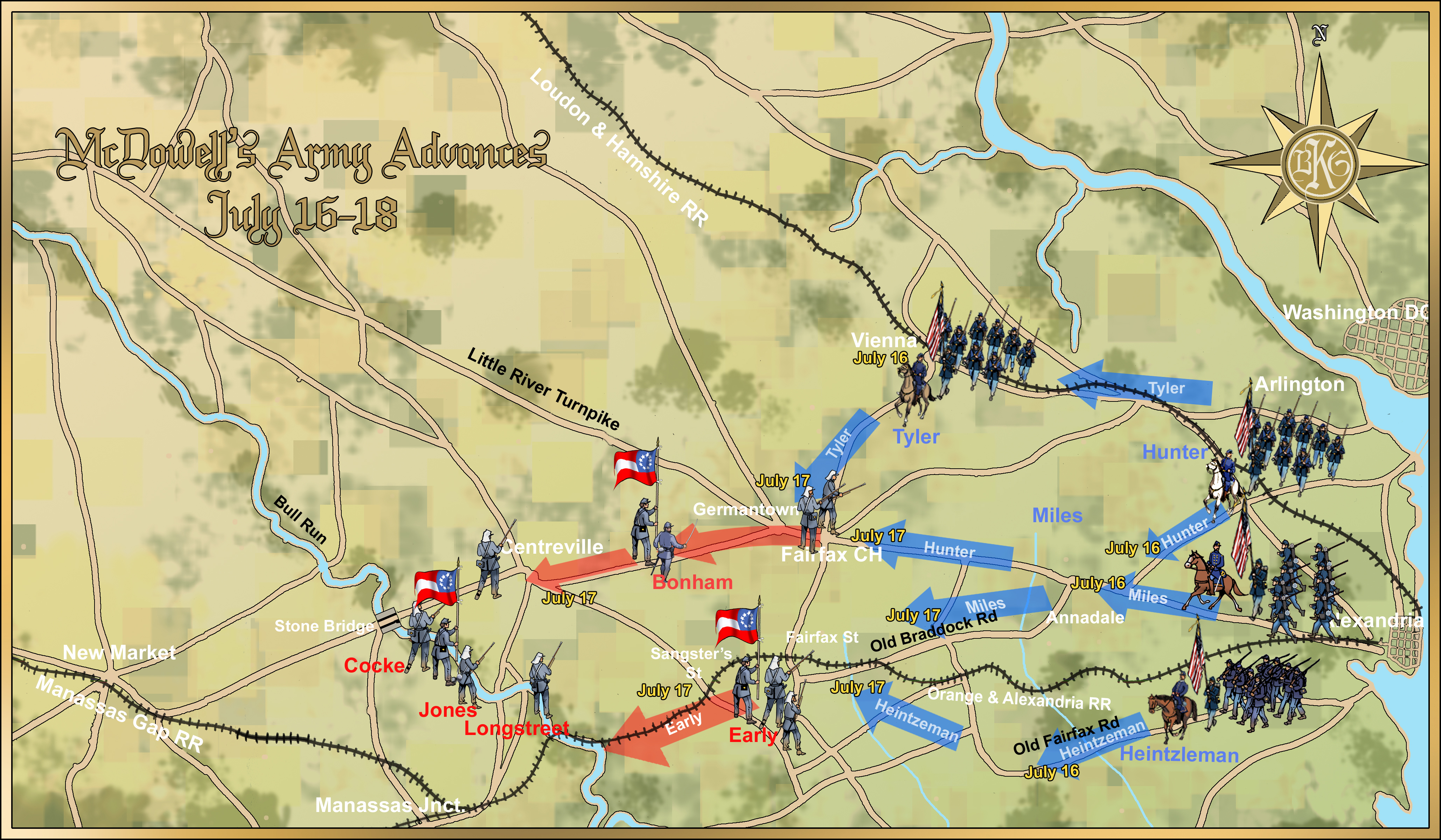
McDowell's target was the massive buildup of Confederate troops at Manassas Junction. These green troops, loaded down with full packs and 3 days rations, would need some time to adjust. The initial advance, a short hike of just 5 miles, finally got under way at 2 pm on the afternoon of July 16th. Gen. Tyler would march to Vienna while Gen. Hunter in the center would advance on the Little River Turnpike and bivouac short of Annadale.Gen. Heintzelman advanced along the Old Fairfax Rd. camping just beyond Accotinik Creek. Col. Miles division was the reseve and camped at Annadale. Retreating confederates did not challenge the advance but left obstructions along the road to impede it. The Federal advance continued on the 17th with Tylers men reaching Germantown and Hunter advancing on Fairfax C.H. Gen. Bonham's Confederate Brigade at Fairfax C.H., under orders not to engage a superior force, fell back to Centreville.The push to envelope Centreville was to begin at first light on July 18. McDowell, unsure of Heintzelman's position on the morning of the 18, undertook a reconnaissance of his very own to Sangster Station and soon realized that " the roads were too narrow and crooked for so large a body of men to move." This large scale advance of McDowell's Army was further hindered by the lack of properly trained cavalry to properly scout ahead and the very fact that these troops, though enthusiastic, were quite green and inexperienced to marching long distances under the broiling sun of a hot & dry summer day.
*For more detailed information of McDowell's advance consult David Detzer's book DONNEYBROOK and Bradley Gottfried's The Maps of First Bull Run (Manassas)

Skirmish at Blackburn's Ford July 18th
Click on each box to see the illustration and a linked pdf of various sections close-up
A New Birth
a poem
by
Brendan Hamilton
Centreville and The Union Army advance to Bull Run
July 20th-21
“On to Richmond,' exhorted the press. “Action!” cried North and South alike, though both armies and their soldiers were unready for real battle. The new Capital of the Confederacy was a hundred miles south of Washington. The Rebel army under the command of General Beauregard, hero of Fort Sumter, stood poised to defend the lone railroad link that ran south to Richmond at Manassas Junction, Virginia. On July 16 the Union army under the leadership of Brigadier General Irwin McDowell, reluctantly set a few Regulars and around 35,000 raw recruits in motion out of their camps near Washington. Most of the units on the march were the 90-day militia men and their tours were almost up. They ambled toward Manassas as if to a picnic. War was a lark and discipline was lax. The roads were dusty, the weather hot and the men could not keep ranks and “stopped to pick blackberries or to get water,” recalled General McDowell.
Several hundred citizens, including Senators and Representatives followed in carriages and wagons packed with picnic lunches to watch the spectacle of a lifetime. Even General Scott in a listing carriage made his way to view this opening action. The hamlet of Centreville was 20 miles and it had taken the army two days to reach it. Here at the intersection of the Warrenton Turnpike and the Methodist stone church the stream called Bull Run behind which the Rebel army waited three miles southwest. Beyond the river, several miles south was Manassas Junction, springboard to Richmond. The church had become a hospital on July 18 when a reconnaissance downstream at Blackburn's Ford ignited a sharp but short little fight that produced some of the wars first casualties.The high ground and knolls around the small village would provide a splendid viewing area for the show that was about to begin. The Generals looking through their field glasses and telescopes would just have to figure out the best way to proceed.
The 11th New York Fire Zouaves, originally under the fallen hero Elmer Ellsworth at the Marshall House back in May, have stripped down to their red shirts and fezs because of the heat for the expected fight. One of the non coms is shouting encouragement thru a speaking trumpet as the regiment takes a left onto the Warrenton Turnpike.These firemen are eager for a fight to show just how tough they are. The coming fight will surprise many of them and see just how courageous they are when the lead begins to fly.

The Flank March and Crossing of Sudley Fords
McDowell had worked up several plans of attack. Upon approval by Lincoln, Scott and the President's Cabinet the Federal army of three columns were set in motion. Two columns would proceed straight ahead as a diversionary attack against the likely center of the Confederate line at Bull Run. The third column would swing around the Confederates' left flank and strike southward, cutting the railroad to Richmond and threatening the Rebel rear. With this flanking movement McDowell hoped to force a Rebel retreat by strategy and superior numbers without a pitched battle. His desire was that lives would be saved and his fledgling army not be crippled and that Washington would feel less threatened. The plan hinged on events farther west where Union General Patterson was keeping an eye on Joseph E. Johnston's army of the Shenandoah pinned down.
Things never go as planned and delay resulted from a wrong turn by a puzzling fork in the road. They had started at 2 a.m. and here it was now 9 a.m. Colonel Andrew Porters' First Brigade of Hunters' Second Division is seen crossing the Sudley Ford along the sandy banks of Bull Run. Captain Charles Griffin 5 th US Artillery is splashing across the Catharpin Run at Sudley Spring Ford. Officers stand atop the stone structure where the spring bubbled forth. A battalion of US Cavalry under Major J. G. Reynolds is crossing the run by Wier Farm to protect the right flank of the advance. The Battalion of US Marines under the command of Major George Sykes have slid to the right to follow an abandoned railroad right of way to extend the line that Burnsides Second Brigade has formed just up the Sudley Road at the Matthew farm as his reserve regiments follow in support.
The landmark Sudley brick church would become a field hospital as the Cooper store combination Post Office across the way. Clouds of dust had alerted the rebels that McDowell's plan had been detected. Confederate signal flags wigwagged. “Look to your left, you are turned.” The Confederates were rushing men to block this bold move.
*I have altered the order of some troops here for better compositon and to illustrate the overlapping story of troops on the move.

